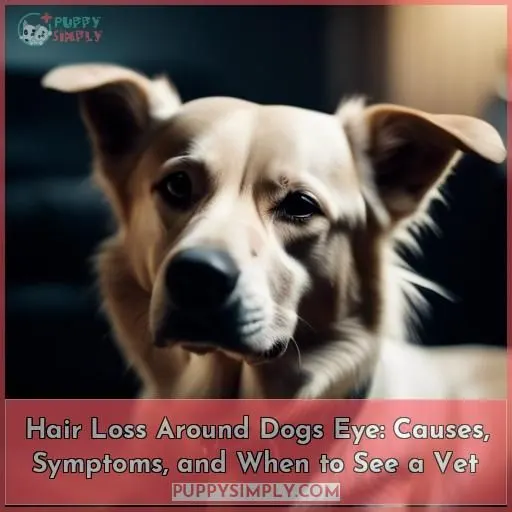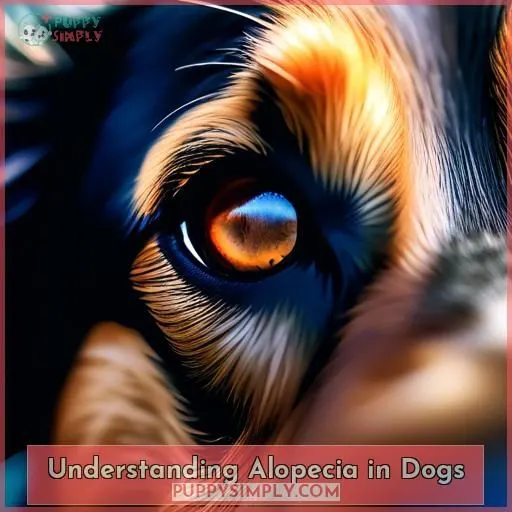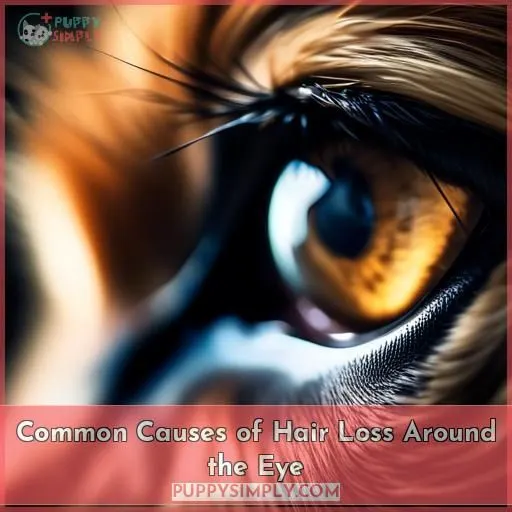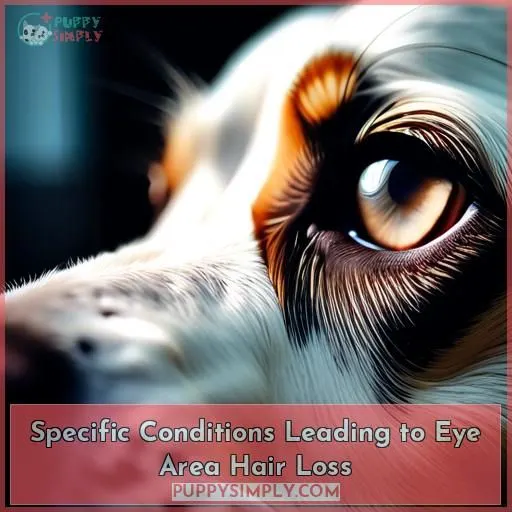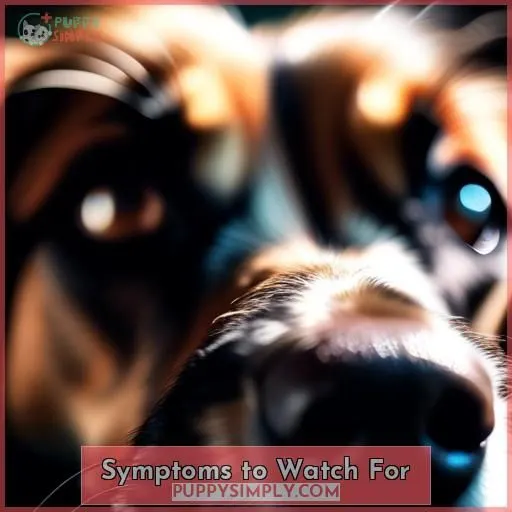This site is supported by our readers. We may earn a commission, at no cost to you, if you purchase through links.
You’re likely noticing hair loss around your dog’s eye due to an underlying issue.
Common causes include allergies, infections (like conjunctivitis or ringworm), parasites (fleas), genetics, or medical conditions like Cushing’s disease.
Symptoms to watch for are excessive itching, redness, bald spots, squinting, and behavioral changes.
If you spot any of these, it’s best to seek veterinary care promptly.
Proper diagnosis and treatment are essential, as hair loss around the eye area can signal a more serious problem that needs addressing.
The following sections provide further insight into this concerning issue.
Table Of Contents
- Key Takeaways
- Understanding Alopecia in Dogs
- Common Causes of Hair Loss Around the Eye
- Specific Conditions Leading to Eye Area Hair Loss
- Symptoms to Watch For
- When to Seek Veterinary Care
- Frequently Asked Questions (FAQs)
- How can I prevent hair loss around my dog’s eyes?
- What is the best treatment for hair loss around a dog’s eyes?
- Can hair loss around a dog’s eyes be a sign of a serious condition?
- How can I tell if my dog has an allergic reaction causing hair loss?
- Can hair loss around a dog’s eyes be a symptom of Cushing’s disease?
- Conclusion
Key Takeaways
- Hair loss around a dog’s eye can be caused by various factors, including allergies, infections, parasites, genetics, and underlying medical conditions.
- Symptoms to watch for include excessive itching, redness, bald spots, squinting, and behavioral changes.
- Proper diagnosis and treatment are essential, as hair loss around the eye area can signal a more serious problem that needs to be addressed.
- Common causes of hair loss around the eye include allergies, infections, infestations, and genetic factors. Treatment options vary depending on the underlying cause.
Understanding Alopecia in Dogs
Alopecia, a term that refers to hair loss or baldness, is a common issue in dogs. It can be caused by various factors, including allergies, infections, parasites, genetics, and underlying medical conditions. Understanding the causes and symptoms of alopecia in dogs is essential for their health and well-being.
Allergies are a common cause of hair loss in dogs, often triggered by food, environmental factors, or parasites. Flea bites are the most common cause of allergic reactions, leading to severe itching around the eyes, which can cause hair loss. Treatment for allergies includes medication, allergy shots, and diet changes to avoid the triggering allergens.
Infections and infestations, such as ringworm fungus, mange mites, and bacteria, can also cause hair loss. Symptoms of these infections may include circular hair loss, inflammation, and infected crusts. Treatment involves antifungal or antibiotic medications to address the underlying infection.
Genetic predispositions can also contribute to alopecia in dogs. Some breeds, such as greyhounds, whippets, Chihuahuas, dachshunds, and Italian greyhounds, are more prone to baldness than others. Bald spots may appear on various body parts, including the outer ear, chest, belly, thighs, or lower neck. Treatment options are limited, and it’s essential to rule out other causes of hair loss before considering intervention.
Itching and redness around the eyes can be a sign of alopecia, as well as bald spots and thinning hair. Behavioral changes, such as excessive licking or biting, may also indicate a problem.
If your dog is experiencing hair loss around the eyes, it’s essential to consult with a veterinarian to determine the underlying cause. Early diagnosis and treatment can help alleviate symptoms and prevent further hair loss.
Common Causes of Hair Loss Around the Eye
Your dog’s hair loss around the eyes can stem from various causes. Allergic reactions, infections, infestations, and genetic factors are common culprits that may lead to bald spots, thinning hair, and irritation near the eye area.
Allergic Reactions
Allergies are a common cause of hair loss around a dog’s eyes.
They can be triggered by various factors such as food, environmental allergens, or parasites like fleas.
Dogs can experience seasonal allergies, which are more common in certain breeds.
Symptoms include itching, redness, and hair loss around the eyes.
Treatment for allergies may include antihistamines, allergy shots, or diet changes to eliminate allergens.
Infections and Infestations
Infections and infestations are prevalent causes of hair loss near a dog’s eye. These can include bacterial infections, fungal infections, and parasite infestations. Here are some crucial points to bear in mind:
- Bacterial infections: These can cause redness, hives, hair loss, pustules, and scabbing. They may occur as a consequence of dermatitis.
- Fungal infections: Fungal infections, such as ringworm, can also cause hair loss in dogs. Symptoms include circular hair loss, inflammation, and infected scabs.
- Parasite infestations: Fleas, ticks, and mites can cause hair loss in dogs. An infection due to fleas, ticks, or mites is another prevalent cause of hair loss in dogs. Hair loss due to a parasitic infection will typically be around the eyes, ears, abdomen, and chest.
If your dog is experiencing hair loss near the eye, it’s crucial to seek advice from a veterinarian. They can help pinpoint the underlying cause and provide appropriate treatment.
Genetic Factors
Genetic factors play a significant role in hair loss around a dog’s eyes.
Some breeds are more prone to baldness than others. Bald spots may appear on the outer ear, chest, belly, thighs, or lower neck.
Breeds like greyhounds, whippets, Chihuahuas, dachshunds, and Italian greyhounds are commonly affected.
Bald spots and thinning hair can be caused by genetic predispositions, which may indicate hair problems in the dog’s eyes or other eye diseases.
Treatment options are limited, and the best approach is to rule out other causes of hair loss.
Specific Conditions Leading to Eye Area Hair Loss
Your dog’s hair loss around the eyes could be caused by specific conditions like pink eye (conjunctivitis), flea infestations, ringworm, or Cushing’s disease. These conditions can lead to inflammation, itching, and subsequent hair loss in the eye area, so it’s critical to identify and address the underlying cause promptly.
Pink Eye (Conjunctivitis)
Just like us, our furry friends can catch pink eye, leading to a not-so-pretty sight of goopy, watery eyes.
Conjunctivitis, or dog pink eye, causes inflammation, pus drainage, and can make your pup’s eyes look like they’ve been in a brawl, with eyelid swelling and noticeable eye pain.
It’s a real eye-opener, literally, and a sign to visit the vet promptly.
Fleas
Fleas are tiny, blood-sucking parasites that can cause severe itching and skin inflammation in dogs. They’re the most common external parasite found on dogs worldwide and can lead to a condition known as flea allergy dermatitis (FAD). When a flea bites your dog, it injects its saliva into the skin, which contains antigens, enzymes, peptides, amino acids, and histamine-like compounds that can trigger an allergic reaction.
Dogs with FAD may not need to be infested with fleas to be itchy. Some dogs will display an immediate hypersensitivity within 15 minutes, while others have a delayed reaction that takes 24 to 48 hours to manifest. A single flea bite can cause a days-long itching episode. Dogs with atopic dermatitis are more likely to develop FAD.
Symptoms of a flea allergy in a dog include:
- Biting and scratching around the base of the tail, rump, and groin area
- Sudden jumping from a resting position when your dog feels a flea bite
- Hot spots of infected sores, usually located on a dog’s legs, back end, or tail
- Secondary skin infections
To prevent flea infestations, it’s imperative to keep your home clean and make sure your dog is on a flea prevention treatment. Regularly inspect your pet for fleas and flea dirt, which are small black specks found in your dog’s fur. If you suspect your dog has a flea allergy, consult your veterinarian for appropriate treatment, which may include antihistamines, corticosteroids, and omega/fatty acid supplements.
Ringworm
Ringworm is a fungal infection that can cause hair loss in dogs, particularly around the eyes.
It’s highly contagious and can spread from pets to humans and vice versa.
Symptoms of ringworm in dogs include circular areas of hair loss, often with a red and crusty edge, broken hair, and a poor hair coat.
The fungus that causes ringworm feeds on dead hair or skin cells.
If your dog has ringworm, it’s essential to seek veterinary treatment to prevent complications, such as corneal ulcers or glassy eyes.
Treatment for ringworm in dogs typically involves oral medication, such as itraconazole or terbinafine, and topical treatments like dips, lotions, or shampoos.
Ringworm can remain infectious in the environment for up to 18 months, so thorough disinfection is imperative.
Cushing’s Disease
Cushing’s Disease, also known as hyperadrenocorticism, is a condition that affects dogs and is caused by the overproduction of cortisol hormone. This hormone is responsible for the body’s response to stress, maintaining blood sugar levels, and fighting infections. Cushing’s Disease can be caused by a benign or malignant tumor in the pituitary gland, located at the base of the brain, or on the adrenal glands, located above the kidneys. It can also be caused by the prolonged use of steroids, known as iatrogenic Cushing’s syndrome.
Symptoms of Cushing’s Disease in dogs include increased appetite, excessive thirst or drinking, thinning of the skin, hair loss, frequent urination, muscle weakness, an enlarged abdomen, panting, and lethargy. If your dog is displaying any of these symptoms, it’s essential to contact your veterinarian immediately, as Cushing’s Disease can lead to severe, sometimes life-threatening conditions and illnesses, such as kidney damage, diabetes, and blood clots.
Cushing’s Disease is diagnosed through a physical examination and various tests, including urinalysis, urine culture, complete blood panel, and full chemistry panel. Adrenal function tests, adrenal low dose and high dose dexamethasone suppression tests, and magnetic resonance imaging (MRI) may also be used to determine the cause of the symptoms and rule out other conditions.
Treatment for Cushing’s Disease in dogs typically involves medications that help decrease the amount of cortisone produced by the adrenal glands. Pituitary tumors are treated with two drugs, trilostane and mitotane, while adrenal tumors may require major abdominal surgery. Iatrogenic Cushing’s disease is treated by gradually discontinuing the steroid, which may result in a recurrence of the disease. Regular monitoring of blood tests and medication adjustments are necessary to control the excessive production of cortisone and minimize health issues caused by the disease.
To prevent Cushing’s Disease, it’s essential to monitor your dog’s health and consult your veterinarian if you notice any symptoms. Regular check-ups and appropriate management of any underlying conditions can help minimize the risk of developing this condition.
Symptoms to Watch For
You’ll want to watch for excessive itching, redness, and hair loss around your dog’s eyes.
These are often the first signs that something is amiss, potentially indicating an allergy, infection, or another underlying condition.
Bald spots and thinning hair in the eye area, along with any abnormal behaviors like squinting, pawing at the face, or head shaking, should prompt you to seek veterinary attention.
Itching and Redness
If your dog’s eyes are red and itchy, it could be due to allergies. Allergies can cause various symptoms, including redness, itching, and inflammation. Common allergens for dogs include pollen, mold, dust mites, and food. If you suspect your dog has allergies, consult your veterinarian for an accurate diagnosis and treatment.
Here are some signs to watch for:
- Redness
- Itching
- Watery discharge
- Sneezing
- Red or inflamed skin
- Hair loss
If your dog’s eyes are itchy, it may paw at its eyes or rub its face. This can worsen irritation and potentially cause more harm.
Allergies can be seasonal or year-round, so it’s important to monitor your dog’s symptoms and consult your veterinarian if you notice any changes. In some cases, allergies may require ongoing treatment, such as allergy shots or dietary modifications.
Remember that it’s imperative to refrain from giving your dog over-the-counter allergy medication or eye drops without first consulting your veterinarian. Appropriate treatment depends on your dog’s specific allergy, which your vet will determine through examination and testing.
Bald Spots and Thinning Hair
After addressing the itchiness and redness, let’s delve into bald spots and thinning hair**.
These aren’t merely aesthetic concerns; they’re indicators of your pup’s health.
From pressure sores in sedentary canines to rashes and hives caused by unknown vegetation, each bald patch narrates a tale.
Even a routine haircut (post-clipping alopecia) or an unassuming growth on your dog’s eyelid could be the responsible party.
Remain vigilant for these signs; they’re your furry friend’s means of signaling an impending issue.
Behavioral Changes
When your furry friend starts acting like they’re auditioning for a blink-a-thon, take note.
Eye irritation can lead to frequent scratching, excessive blinking, and an uptick in tear production.
If they’re rubbing their face more than a DJ spins records, it’s a clear signal.
These behavioral changes are your cue; they’re not just quirky habits but signs your pup needs a vet’s attention, promptly.
When to Seek Veterinary Care
When you observe hair loss around your dog’s eyes, it’s essential to take swift action.
Skin irritation, allergic reactions, fungal infections, and parasitic infestations can be potential culprits. If your dog is excessively scratching, biting, or licking the affected area, it may signal an underlying issue.
Examine for signs of bald patches, thinning hair, and changes in behavior. If these symptoms persist or escalate, consult your veterinarian.
They can assist in diagnosing the problem and offering appropriate treatment, such as antihistamines, antibiotics, or antifungal medications.
Don’t delay, as early intervention can prevent further hair loss and potential complications.
Frequently Asked Questions (FAQs)
How can I prevent hair loss around my dog’s eyes?
To prevent hair loss around your pup’s eyes, you’ll want to tackle any underlying allergies or infections. Monitor for excessive itching or redness, and see your vet ASAP – they can pinpoint the cause and get that furry face back in tip-top shape!
What is the best treatment for hair loss around a dog’s eyes?
You’ll want to tackle that hair loss around your pup’s eyes like a pro! After ruling out any underlying conditions with your vet, medicated shampoos or topical creams may work wonders to restore that furry glow.
Can hair loss around a dog’s eyes be a sign of a serious condition?
Yes, hair loss around a dog’s eyes can signal a serious condition like an allergic reaction, infection, or autoimmune disorder. You’ll want to have your vet examine your pup to identify and properly treat the underlying cause.
How can I tell if my dog has an allergic reaction causing hair loss?
Keep an eye out for constant scratching, a rough coat, or red, inflamed skin – telltale signs your pup’s dealing with pesky allergies causing hair loss. A vet visit can pinpoint triggers and provide itch relief for that furry friend.
Can hair loss around a dog’s eyes be a symptom of Cushing’s disease?
Yes, Cushing’s disease could cause hair loss around a dog’s eyes. This hormonal condition leads to excessive cortisol production, which can make fur thin and fall out, even around sensitive eye areas. If you notice this symptom, get your pup checked by the vet.
Conclusion
Certainly, when your canine companion encounters the unfortunate sight of hair loss around its eye, it indicates an underlying condition that requires immediate attention.
Carefully observing symptoms such as itching, redness, and changes in behavior, along with a timely veterinary consultation, is crucial for an accurate diagnosis and effective treatment.
Ignoring this issue could worsen the underlying problem, potentially jeopardizing your furry friend’s health.
Take prompt action to restore their comfort and radiant appearance.

